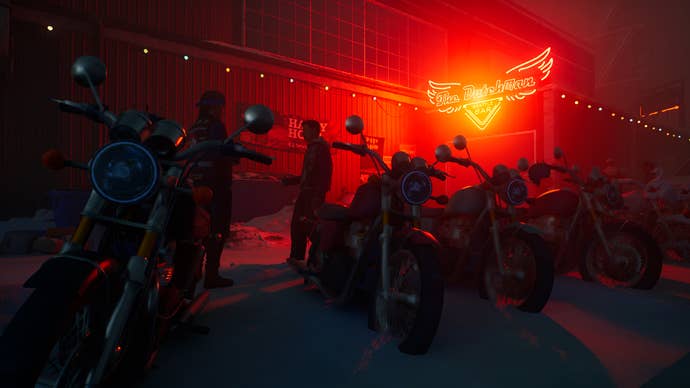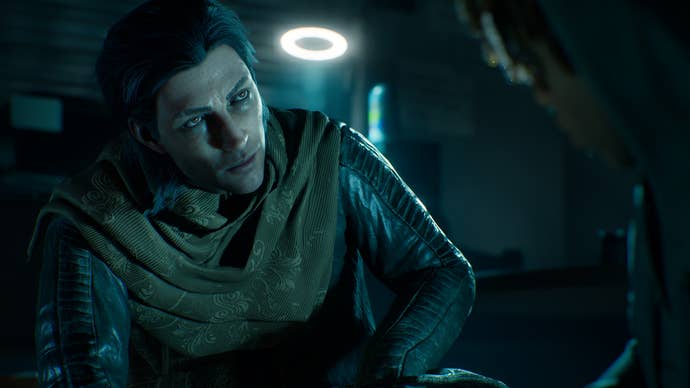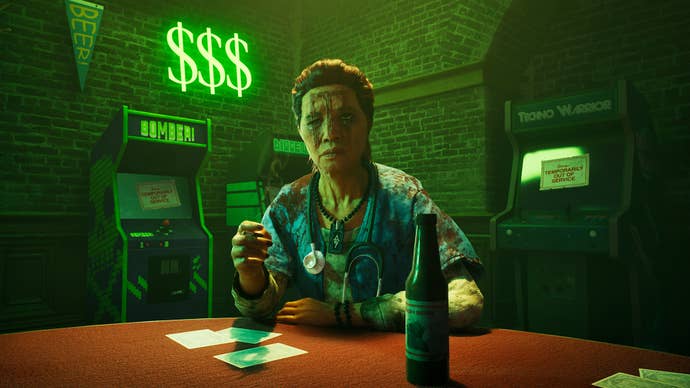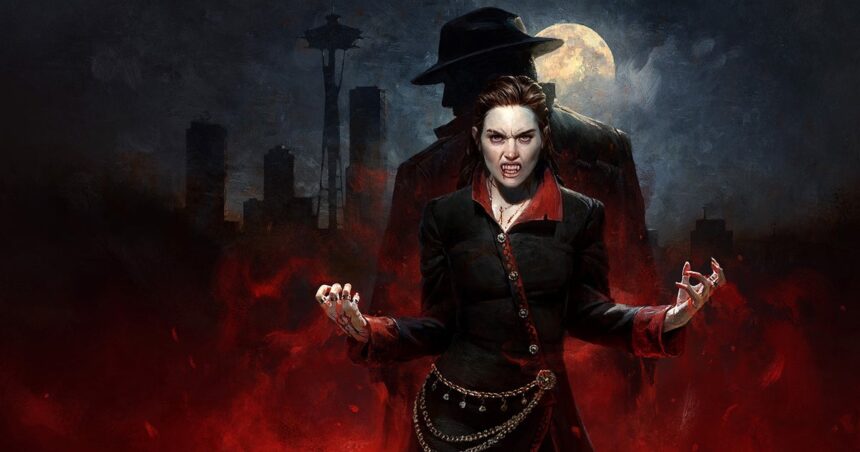I can’t hide it: I’m a little disappointed. The wait for Vampire: The Masquerade – Bloodlines 2 has been an excruciating one. This is the long-awaited follow-up to the flawed but respected Bloodlines 1 from 2004, and it was originally announced in 2019 with a release date of 2020. But it was systematically delayed, then full-on suspended, before being resurrected at The Chinese Room (Still Wakes the Deep) where it’s been reshaped for release. Bloodlines 2 has had problems. The question is: does it still have problems and has it been worth the wait?
Having played Bloodlines 2 for a few hours in a preview build my answer – frustratingly for you – is I’m not sure. I have mixed feelings. There are things I really like about it – I love how powerful it makes you feel as a vampire from the very beginning of the game; the action feels great – but I’m concerned by how narrow the game is as a role-playing experience. Too often I feel led through metaphorical corridors from point A to B, as though I’m playing a predetermined experience rather than shaping one of my own. I think it’s telling that Paradox is leaning into the “action” part of the “action RPG” descriptor; from what I’ve played, this is more like an action or stealth game, with some RPG elements, rather than the other way around. And given the extensive and exhaustive resource material involved – a tabletop RPG that’s been running for decades – that disappoints me. But there are upsides to this approach.
The things I like, then: Bloodlines 2 wastes no time making you feel cool. You do not wake as a fledgling vampire but an elder one who’s been asleep for a hundred years. From the moment you take control of this character – a character cringingly called “Phyre” (“fire”), and who likes to announce their name at every given opportunity – you can already do incredible things. You can scramble up walls like a spider, even entire buildings if you plan your route right, and leap off the other side, to the ground, and take no damage. You can move with blur-like vampire speed, float through the air, and punch people so hard they float – well, fly – through the air. You can telekinetically grab at objects and then hurl them wherever you want. You can even telekinetically grab people. There’s no gradual build-up of power here: you are, from the beginning, a beast.
Watch on YouTube
It feels great. There’s a snap and a pace and a wallop to everything you do. Even a small thing like climbing up a ladder is sped-up so that it’s like doing it on fast-forward. And as you start to unlock more powers as you level up, which differ slightly depending on which of the game’s six clans you join – I joined the Brujah clan, which are brawlers – the action gets more ridiculous still. (Note: two of the clans you have to pay to unlock, which is grubby.) I have a Lightning Punch ability that rapidly strikes, countless times, anyone who I ‘mark’ nearby to be punched. I pulverize them in a blur of action. I have a charge that makes me thunder towards anyone in my path and pick them up and slam them into whatever I’m running towards. Tactility: there’s a lot of it here.
This is the upside to the game’s somewhat obvious action focus. The more linear approach to levels and situations also means areas have been shaped specially to encourage entertaining, platformer-like traversal, and that they’ve been decorated to a high degree because designers know where the level you’ll be. Take the derelict building you wake up in, for example: there’s only one route through it as you work your way onto the roof, away from inquisitive police, so visually, the crumbling ruin of the place is writ large all around you. Developer Chinese Room showed what flair it has for environmental storytelling in Still Wakes the Deep, on that wonderfully touchable and dilapidated 1970s oil rig, and you can see that expertise here too. The dimly lit griminess of it. The posters on the wall. The graffiti. The walls smeared in blood. It’s exactly the atmosphere a Bloodlines game begs for. The detail in your home-base apartment, a kind of disgusting, makeshift laboratory, is incredible.
.jpg?width=690&quality=70&format=jpg&auto=webp)
.jpg?width=690&quality=70&format=jpg&auto=webp)
.jpg?width=690&quality=70&format=jpg&auto=webp)
Nice though they are to look at, in these areas there’s little you can actually interact with – a problem that carries right across the game. Take the city of Seattle, for instance, where the game’s set. It looks nice, caught as it has been in heavy snowfall, and moody in the dark, lit by pools of streetlight or car headlights. But the only doors you can interact with are the ones that lead to specific quest objectives, of which there are only one or two in the preview build, and the only people you can interact with… Well, you can utter a few words to some people, in an effort to lead them into an alley to drink their blood, which regenerates health or regains special ability charges, or earns you a kind of upgrade currency, but that’s about it. For the most part, it feels like a place filled with non-interactive extras.
This feeling extends to the building environments you enter. There’s a hotel lobby that’s full of people at a Christmas do, but I can’t interact with any of them. Then, when I get to the more gamey areas of the hotel, which are where I’ll fight some packs of low-level vampires – thugs, really – there’s no one else around. These halls and corridors are mostly empty with only occasional clusters of enemies there. It’s a bit dull. Even the more central characters don’t inspire much excitement when you meet them. They’re nice enough to look at but predictable to the point of stereotype – with exception of Tolly, a disfigured nosferatu who injects much needed humour and charisma – and the interactions with them feel stiff. There’s not much intrigue in the dialogue. You can provoke reactions, such as arousal or embarrassment or annoyance, which suggests these things mean something in a gameplay sense, but how that plays out is unclear for now from what I’ve played.



Thankfully the story does have some intrigue of its own – it’s literally embedded in you. You wake with not so much a voice in your head as a whole other personality, who happens to be – bizarrely but brilliantly – a noir-style private investigator, which prompts an amusing clash of styles between him and his overly dramatic inner monologues, and your surliness. It also allows you an on-board narrator who can explain the world as you adventure through it. Actually, the best part of the preview came when inhabiting the PI-style character through a memory of his, because he had access to a different range of vampire abilities – mind-affecting ones. The gameplay challenge here became extracting information through dialogue from characters who didn’t necessarily want to give it, which was much more interesting than rote battles with uninspiring packs of vampire thugs. It was a glimpse at the sort of thoughtful dialogue interaction I had hoped the game would have.
Look, there’s still hope. This, it’s worth remembering, is a preview build of a game still a couple of months from release, and it’s only the start of the experience – the part that typically lays some ground rules before opening up and letting you do what you want to do. I fully expect this empty-feeling Seattle playground to populate with places to go and people to meet. At least, I hope that’s the case. But I also expect a preview build to be designed to showcase the best parts of the game I’m previewing, and for the beginning of a game to grab and dazzle a player, and convince them to stick around. I did enjoy some of what I played, and I’m willing to give it another go. But I wasn’t grabbed or dazzled.
I’m always wary of critiquing a game for what it’s not, rather than meeting it where it is – and just to emphasise, the focus on action here makes plenty of sense. But this is a sequel to a cult RPG after all, and one based on a major tabletop RPG to boot. In this case it feels valid to crave a little more role-playing, a little more texture and depth to the game’s people and conversations. And so for now, a question mark remains.





